Balbharti Maharashtra State Board Class 9 English Solutions My English Coursebook Chapter 4.2 Reading Works of Art Notes, Textbook Exercise Important Questions and Answers.
Maharashtra State Board Class 9 My English Coursebook Solutions Chapter 4.2 Reading Works of Art
My English Coursebook Std 9 Guide Chapter 4.2 Reading Works of Art Textbook Questions and Answers
English Workshop:
1. Spot the error in the spellings of the following words with reference to the passage and rewrite them correctly.
Question 1.
Spot the error in the spellings of the following words with reference to the passage and rewrite them correctly.
- renouned
- feetures
- pentmgs
- circals
- inflar
- geometic
- figars
- achiving.
Answer:
- renowned
- features
- paintings
- circles
- inner
- geometric
- figures
- achieving.
![]()
2. Complete the following diagram:
Question 1.
Complete the following diagram:

Answer:

3. Complete the following sentences with reference to the passage:
Question 1.
Complete the following sentences with reference to the passage:
(a) Raza’s paintings do not depict …………………. .
(b) Raza’s paintings are done in the style ……………… .
(c) Raza’s paintings are not inspired by ………………. .
(d) Raza’s paintings present images from his own …………….. .
(e) Raza’s paintings radiate ……………. .
(f) The …………….. became the core of Raza’s paintings.
(g) For an artist like Raza, his work, or paintings are an effective …………………. .
Answer:
(a) Raza’s paintings do not depict lifelike human figures or copies of scenes.
(b) Raza’s paintings are done in the abstract style.
(c) Raza’s paintings are not inspired by any external factor.
(d) Raza’s paintings present images from his own inner mind.
(e) Raza’s paintings radiate peace.
(f) The bindu or point became the core of Raza’s paintings.
(g) For an artist like Raza, his work, or paintings are an effective medium of communication.
4. Read the passage on ‘Gond Art’ carefully. Then complete the following sentences without going back to the passage:
Question 1.
Read the passage on ‘Gond Art’ carefully. Then complete the following sentences without going back to the passage:
Answer:
- Gond art is a tribal art.
- The Gondi language is similar to Telugu, a Dravidian language.
- Originally people used to draw pictures on the earthen walls of their houses.
- In folk arts, you yourself prepare the ‘canvas’ – the surface on which to draw and the colours with which you draw.
![]()
5. Write about the following important features of Gond art with the help of the passage.
Question 1.
Write about the following important features of Gond art with the help of the passage.
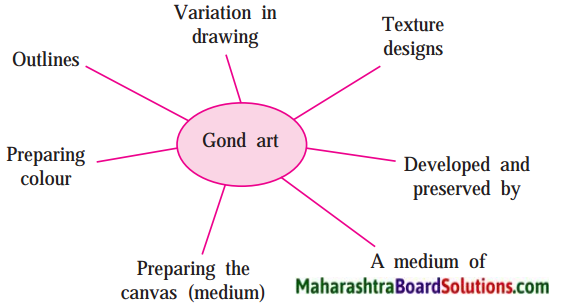
Answer:
1. Developed and Preserved by: The Gond tribal people residing largely in Madhya Pradesh, Maharashtra, Telangana, Andhra Pradesh and Odisha in India.
2. A medium of: It is a medium of expressing, recording and preserving what is seen. people used to draw pictures on earthen walls of their homes itself.
3. Preparing colours: In the days of the past several things in nature such as soil of different shades, the juice of plants, leaves, tree bark, flowers, fruits and even things like coal and cow-dung were used to prepare colours.
4. Outlines: In the Gond style of art, the designs may vary a little from artist to artist but the designs that fill it make the whole picture look lively and attractive.
5. Variation in drawing: The colours, textures and patterns used in drawing vary from painting to painting.
6. Texture designs: By using dots, straight lines, dotted lines, curvy shapes and circles simple texture designs are made.
6. Why does the author think that the roots of folk art lie in women’s chores?
Question 1.
Why does the author think that the roots of folk art lie in women’s chores?
Answer:
In the past, it was the duty of women to look after her home and hearth. It included decorating the house with different things like flowers, rangolis. They handled it very creatively while shouldering the other responsibilities of their home. They used their own creativity while doing it, so the author thinks that the roots of folk art lies in women’s chores.
7. From the passages, list the words related to – (a) geometry (b) colours (c) designs.
Question (a)
geometry
Answer:

Question (b)
colours
Answer:
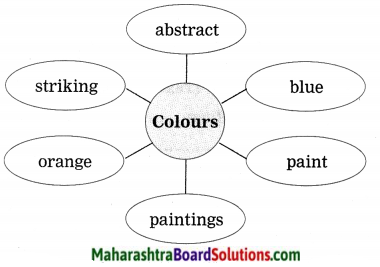
Question (c)
designs.
Answer:
human figures, scenes, abstract.
![]()
8. These two passages are examples of a short introduction to works of art – a short review. They cover the following points:
Question 1.
These two passages are examples of a short introduction to works of art – a short review. They cover the following points:
Answer:
- The name of the creator
- The theme or subject matter
- Type of art
- Individual style
- Presentation techniques
- Its effect on viewers
- Message or interpretation
Question 2.
What points will you include if you had to review a book or film or a play? List the points.
Answer:
If I had to review a book, a film or play, I would like to include the following points:
- The theme of the book/film/play.
- The plot and the story.
- The characters in the book/film/play.
- Flow of language and style of narration.
- Authenticity of the book/film/play (story).
- The message conveyed in the book/film/play.
Question 3.
Choose a book/film and review it in short using the points you have listed.
Answer:
Review of the book
The Three Mistakes of My Life
‘The Three Mistakes of My Life’ is a novel written by Chetan Bhagat who writes about Indians and for Indians. His characters are young and passionate. The novel follows the story of three friends and is based in the city of Ahmedabad in Gujarat.
Govind Jaat Patel is an ordinary guy with whom anybody can relate. Being a Gujarati his ambition is to become a businessman. His friend is Omi who is the son of a Hindu priest of the local temple. He is confused about his religious views which are mainly influenced by Bitoo Mama. Ishan is a big cricket freak and a patriot.
He was the best cricketer in his locality and school. He helps Govind’s business by organizing daily cricket coaching camps. He has a younger sister Vidya who is weak in Mathematics. Ishan asks Govind to take her Mathematics tuition. In between their tuition, they fall in love which is kept secret.
The whole story revolves around Govind and his friends and the three mistakes he made. It is pop- fiction of lightest, laziest sort, which tackles serious real-life issues and incidents giving it a veneer of earnest thoughtfulness that stands up to nothing. It is written simply and has the quality that makes one want to read the book in one sitting. The target audience of the book is the young generation. It is based on fun, emotion and pace to turn it into a potential best-seller.
![]()
9. You know that an adverb is a word that tells us something more about a verb, an adjective, another adverb etc. It can give us information about the place, time, manner etc. of the action denoted by the verb.
For example, ‘here’ tells us a place. ‘Now’ gives us information about time. ‘Fast’ gives us information about manner. In the same way, an adverb clause is a group of words that can also tell us something about place, time, manner etc. of the action denoted by the verb. Read the following examples, given and then complete the sentence using your own ideas:
Question (a)
Place: You may sit wherever you like.
You may sit ………………………………..
Answer:
(a) Place: You may sit wherever you like.
You may sit next to Ishan.
Question (b)
Time: I entered the school when the bell was ringing.
I entered the school ……………………..
Answer:
(b) Time: I entered the school when the bell was ringing.
I entered the school with my classmates.
Question (c)
Manner: I love my country like a true Indian should.
I love my country………………………….
Answer:
(c) manner: I love my country like a true Indian should.
I like my country more than you.
My English Coursebook 9th Class Solutions Chapter 4.2 Reading Works of Art Additional Important Questions and Answers
Simple Factual Activities:
Question 1.
Name the following:
Answer:
- The state where Raza was born – Madhya Pradesh
- The institute where he studied art – Chitrakala Mahavidyalaya, Nagpur
- The institute where he took his higher education in Mumbai – J. J. School of Art, Mumbai
- The country he settled – France
![]()
Question 2.
Complete the following web :
(Answers are directly given.)
Answer:
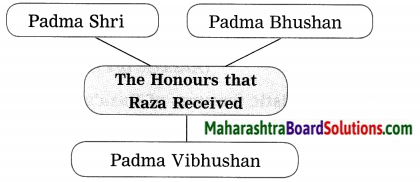
Question 3.
Complete the following sentences with reference to the passage: (Answers are directly given.)
Answer:
1. Raza passed away on 23rd July 2016.
2. Raza’s wife was French.
Question 4.
Complete the following web-chart:
(Answers are directly given.)
Answer:
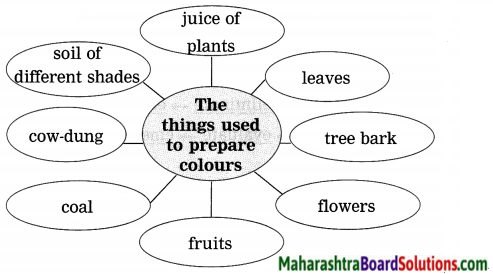
Complex Factual Activities:
Question 1.
How did Raza And his paintings?
Answer:
Raza found his paintings through the study of Indian art and its heritage, cultural context and philosophy.
Question 2.
What are the specialities of Raza’s paintings?
Answer:
The specialities of Raza’s paintings are:
- His paintings belong to the abstract style of paintings.
- They are not inspired by any external factor whereas based on inner mind of the painter.
- They communicate with the viewers.
![]()
Question 3.
What are Raza’s paintings based on? How did he describe his work?
Answer:
Raza’s paintings are based on spirituality, metaphysical path and the bindu or point. He described his work as his own inner experience and involvement with the mysteries of nature and form, which is expressed in colour, line, space and light.
Question 4.
What legacy did Raza leave behind?
Answer:
Raza left behind a rich legacy of sensitive paintings (achieved through extraordinary compositions of lines and colours) that depict extraordinary compositions.
Question 5.
Complete the following sentences:
(Answers are directly given.)
Answer:
1. In the Gond style of art, outlines may vary from artist to artist but the designs that fill it make the whole picture look lively and attractive.
2. The designs in Gond style art contain simple textures of dots, straight lines, dotted lines, curvy shapes and circles.
Activities based on vocabulary:
Question 1.
Find out antonyms from the passage for the following words: (Answers are directly given.)
Answer:
- outer × inner
- city × village
- ordinary × extraordinary
- international × national
![]()
Question 2.
Spot the error in the spelling of the following words and rewrite them correctly:
1. dicided
2. diffarent
Answer:
1. decided
2. different.
Question 3.
Write related words with “Artist”.
Answer:
design, outlines, picture, texture, pattern, style.
Activities based on contextual grammar:
Question 1.
Identify the tense:
1. You will find them in almost all paintings.
2. Raza found his paintings through his study of Indian art.
Answer:
1. Simple future tense
2. Simple past tense
Question 2.
Frame a Wh-type question to get underlined part as an answer:
Answer:
1. His paintings belong to the abstract style of paintings.
2. Sayed Haider Raza is popularly known as Raza.
Answer:
1. What do his paintings belong to?
2. What is Sayed Haider Raza popularly known as?
![]()
Question 3.
Change the voice:
1. He was honoured with all the three Padma awards – Padma Shri, Padma Bhushan and Padma Vibhushan.
2. Raza left behind a legacy of sensitive paintings.
Answer:
1. The Government of India honoured him with all the three Padma awards – Padma Shri, Padma Bhushan, and Padma Vibhushan.
2. A legacy of sensitive paintings was left behind by Raza.
Question 4.
Make the following sentences exclamatory:
1. His paintings are very expressive.
2. Raza had a great creativity.
Answer:
1. How expressive his paintings are!
2. What a great creativity Raza had!
Question 5.
What a deep thought this art conveys! (Make it assertive.)
Answer:
This art conveys a very deep thought.
Question 6.
Creating folk art is a very enriching experience. (Make it exclamatory.)
Answer:
What an enriching experience creating folk art is!
Question 7.
Complete the words using correct letters:
- s_ene
- st _ le
- pa_nt
- c_ eate
Answer:
- scene
- style
- paint
- create.
Question 8.
Copy the following sentences correctly:
Answer:
1. He studied art at the J. J. School of Art in Mumbai.
2. What a deep thought this art conveys – and so easily !
![]()
Question 9.
Put the following words in alphabetical order:
1. vicious, dreadful, thrilled, favourable
2. enchanted, enabled, explained, endangered.
Answer:
1. dreadful, favourable, thrilled, vicious,
2. enabled, enchanted, endangered, explained,
Question 10.
Punctuate the following sentences:
1. ariel my joyful spirit said prospero bring ferdinand here at once for my daughter must see him
2. most sure she is the goddess of the island he thought to himself
Answer:
1. “Ariel, my joyful spirit,” said Prospero. “Bring Ferdinand here at once, for my daughter must see him.”
2. “Most sure, she is the goddess of the island!” he thought to himself.
Question 11.
Write four small words (minimum letters each) using the letters given word: “treacherous”
Answer:
- teacher
- reach
- each
- ache.
Question 12.
Spot the error and rewrite the correct sentences:
1. Prospero touch Miranda with his magic stick and she fell fast asleep.
2. How happy Alonso was to saw his lost son !
Answer:
1. Prospero touched Miranda with his magic stick and she fell fast asleep.
2. How happy Alonso was to see his lost son !
Question 13.
Write related words as shown in the example: (Answers are directly given.)
Answer:
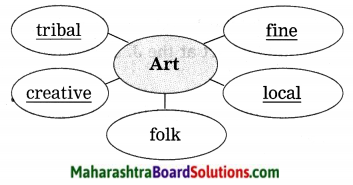
Question 14.
Complete the following word-chain of verbs. Write four words, each beginning with the last letter of the previous word:
explore → ……………… → ………………. → ……………… → ………………….
Answer:
explore → eliminate → embrace → evaluate → emerge.
![]()
Do as directed:
Question 1.
Make a meaningful sentence by using the following phrase in your own sentence.
‘to settle down’.
Answer:
It is pretty difficult to settle down in cities like Mumbai.
Question 2.
Add a prefix or suffix to make new words and use any one of the root words in your own sentence:
1. rich
2. effect.
Answer:
1. rich-enrich
2. effect-effective.
The painter has used rich attractive colour combinations in his painting.
Question 3.
Add a subordinate clause to expand the sentence meaningfully:
You can see my paintings ………………………..
Answer:
You can see my paintings when vou come to mv house.
Personal Response:
Question 1.
Write 4-5 sentences about any other Indian painter you like.
Answer:
M. F. Husain is my favourite modern painter who was born in Pandharpur town of Maharashtra. He is one of the most famous artists of India both at the national as well as the international level. M. F. Husain was once called ‘the Picasso of India’ by the Forbes magazine. The Government of India awarded the prestigious Padma Shri and Padma Bhushan for his work.
![]()
Question 2.
What are the essential things required to become a good painter?
Answer:
The essential things that are required to become a good painter are :
- interest in painting
- a good concentration skill
- capacity to sit for a long time at one place
- good eyesight
- imagination
- the knowledge of mixing colours.